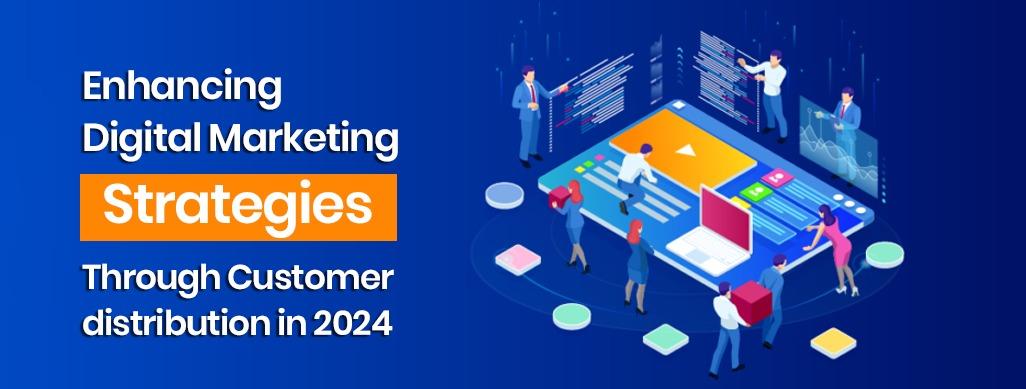
Quick Summary: Customer segmentation is a powerful tool that can significantly enhance your digital marketing efforts. By understanding and implementing effective segmentation strategies, businesses can stay at the forefront of digital marketing trends, delivering more personalized, relevant, and impactful campaigns.

In today’s rapidly evolving digital landscape, businesses are constantly seeking ways to stay ahead of the curve and maximize their marketing efforts. One of the most effective strategies to achieve this is through customer segmentation. By understanding and implementing this powerful tool, companies can tap into the latest digital marketing trends and drive significant growth. Let’s explore how customer segmentation can revolutionize your digital marketing approach and help you stay on top of emerging trends.
Customer segmentation is the process of dividing your target audience into distinct groups based on shared characteristics, behaviors, or preferences. This approach allows businesses to tailor their marketing efforts to specific segments, resulting in more personalized and effective campaigns. As digital marketing trends continue to evolve, customer segmentation becomes increasingly crucial for businesses looking to stay competitive and relevant in the digital space.
Why Customer Segmentation Important For Digital Marketing Success?

Here are some key points on why customer segmentation is important for digital marketing success:
One of the primary benefits of customer segmentation is the ability to create highly targeted marketing campaigns. By understanding the unique needs and preferences of different customer groups, businesses can craft messages that resonate with each segment. This targeted approach aligns perfectly with current digital marketing trends, which emphasize personalization and relevance in marketing communications.
Customer segmentation enables businesses to provide a more tailored and satisfying experience for their audience. By understanding the specific needs and preferences of each segment, companies can offer personalized product recommendations, content, and services. This level of customization is a key component of successful digital marketing trends, as consumers increasingly expect brands to cater to their individual needs.
Implementing customer segmentation can lead to more efficient allocation of marketing resources. By focusing efforts on the most promising segments and using channels that are most effective for each group, businesses can optimize their marketing spend. This approach is particularly valuable in the ever-changing landscape of digital marketing trends, where new platforms and technologies are constantly emerging.
In a crowded marketplace, customer segmentation can provide a significant competitive edge. By understanding your audience better than your competitors, you can create more compelling offers and marketing messages. This deep insight into customer needs and behaviors is essential for staying ahead in the fast-paced world of digital marketing trends.
Segmented marketing campaigns typically yield higher response rates compared to broad, one-size-fits-all approaches. When customers receive messages that are relevant to their interests and needs, they are more likely to engage with the content and take desired actions. This increased engagement is crucial for success in current digital marketing trends, which prioritize meaningful interactions over mass communication.
Customer segmentation provides valuable insights that can inform various aspects of your business strategy, beyond just marketing. These insights can help in product development, customer service improvements, and overall business growth. As digital marketing trends continue to emphasize data-driven decision-making, the insights gained from segmentation become even more valuable.
Segmentation allows businesses to understand and cater to customers at different stages of their lifecycle. From acquisition to retention and loyalty, companies can craft strategies that address the specific needs of customers at each stage. This lifecycle approach is a key component of many current digital marketing trends, which focus on nurturing long-term customer relationships.
Here are the main types of customer segmentation:
This type of segmentation divides customers based on characteristics such as age, gender, income, education, and occupation. Demographic segmentation is a foundational element in many digital marketing services, as it provides a basic framework for understanding your audience.
Geographic segmentation groups customers based on their location, including country, region, city, or even climate. This approach is particularly relevant in the context of current digital marketing trends, which often emphasize local and location-based marketing strategies.
This method focuses on customers’ lifestyles, values, attitudes, and interests. Psychographic segmentation is becoming increasingly important in digital marketing trends, as it allows for more nuanced and emotionally resonant messaging.
Behavioral segmentation groups customers based on their actions, such as purchasing habits, brand interactions, and product usage. This type of segmentation is crucial in many digital marketing trends, particularly those related to personalization and predictive analytics.
Here are the key steps to effectively use customer segmentation in your digital marketing strategy:
The first step in leveraging customer segmentation is to identify and define your key segments. This process involves analyzing your customer data to uncover patterns and commonalities. Utilize tools and technologies that align with current digital marketing trends, such as AI-powered analytics platforms, to gain deeper insights into your audience.
Once you’ve identified your segments, develop messaging and content that speaks directly to each group’s needs, preferences, and pain points. This targeted approach is at the heart of many digital marketing trends, which emphasize the importance of delivering the right message to the right person at the right time.
Different customer segments may prefer different communication channels. Some might be more active on social media, while others respond better to email marketing. Align your channel strategy with the preferences of each segment, and stay attuned to emerging digital marketing trends that may introduce new channels or platforms.
Continuously monitor and analyze the performance of your segmented campaigns. Use metrics that align with current digital marketing trends, such as engagement rates, conversion rates, and customer lifetime value. This ongoing measurement allows you to refine your segmentation strategy and stay ahead of evolving trends in the digital marketing landscape.
Customer segmentation is a powerful tool that can significantly enhance your digital marketing efforts. By understanding and implementing effective segmentation strategies, businesses can stay at the forefront of digital marketing trends, delivering more personalized, relevant, and impactful campaigns. As the digital landscape continues to evolve, those who master the art of customer segmentation will be well-positioned to thrive in the competitive world of online marketing. Embrace this approach, and watch as your digital marketing efforts yield greater results and drive substantial business growth.
Join our growing community and get inspiring articles.
Our highly trained talented teams are committed to providing you with top-level, technical or any other support 24*7.
Ready to get started? Give us a call.